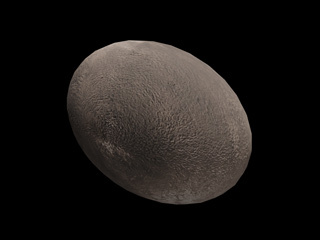NASA scientists studying this strange dwarf planet’s origins

Scientists at NASA's Goddard Space Flight Center in Greenbelt, Maryland are studying the dwarf planet Haumea - one of the most unusual objects in the solar system.
The Pluto-sized planet is found in the Kuiper Belt of icy worlds beyond the orbit of the outermost planet Neptune. What makes this dwarf planet strange is its fast spin - completing a “day” in only four hours. Because of its fast spin, Haumea is shaped like a deflated American football instead of a sphere.
Secondly, the planet's surface is unlike almost any other surface in the Kuiper Belt, making up the only known family of objects in the Kuiper Belt.
"How did something as weird as Haumea and its family come to be?" said Jessica Noviello, a scientist at NASA's Goddard Space Flight Center.
Noviello and her colleagues turned to computer models to understand the chemical and physical processes that shaped the dwarf planet. They began by feeding three pieces of information into their models - Haumea's estimated size and mass, and its rapid spin.
The team assumed that baby Haumea was 3% more massive to account for the family members that once were part of it and that it likely had a different spin rate and was bigger in volume. They then slightly changed one of these features at a time in their models. For instance, they tweaked Haumea's size up or down and ran dozens of simulations to see how small changes in its early years would influence the planet's evolution.
Next, based on their modelling, the team hypothesize that when the planets were first forming and everything was zipping around the solar system, Haumea collided with another object.
"Though this impact would have knocked off pieces, Noviello and her colleagues suggest that those pieces are not the Haumean family we see today, as other scientists have proposed. Such a powerful impact, they say, would have knocked off bits of Haumea into much more scattered orbits than the family members have," according to a statement.
According to Steve Desch, professor of astrophysics at Arizona State University in Tempe, who worked with Noviello and other colleagues on the modelling experiment, the Haumean family we see today instead came later, as the dwarf planet's structure was taking shape: dense, rocky material was settling to the center while lighter density ice was rising to the surface, and "when you concentrate all the mass towards the axis, it decreases the moment of inertia, so Haumea ended up spinning even faster than it does today.”
The researchers quickly calculated that ice flung off the surface forming the Haumean family.
Marc Neveu, a NASA Goddard researcher and the paper co-author found that Haumea's rocks generated heat that melted some ice, creating an ocean below the surface (no longer there).
- READ MORE ON:
- dwarf planet Haumea
- solar system
- NASA









